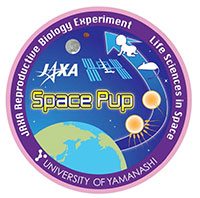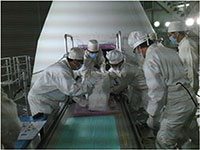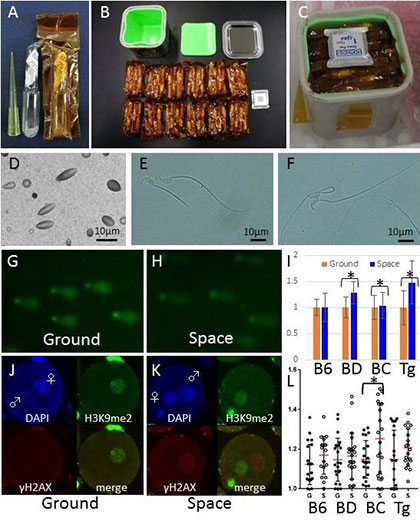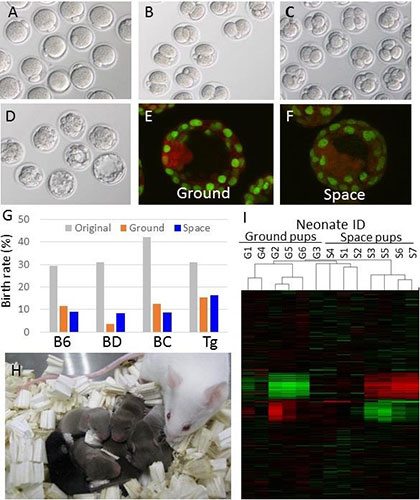Space mice and normalcy of spermatozoa DNA preserved long-term onboard “Kibo” on the International Space Station
-Demonstrating the potential of mankind’s reproduction in space-
Last Updated:
July 6, 2017
National University Corporation University of Yamanashi
National Research and Development Agency, Japan Aerospace Exploration Agency
【Overview】
The research group led by Sayaka Wakayama (specially appointed assistant professor), Teruhiko Wakayama (professor of advanced technology, department of interdisciplinary research, graduate school, the University of Yamanashi), and Yukiko Yano (chief research and development officer, JAXA) clarified the extent of DNA damage in mouse spermatozoa preserved for a long period onboard the Japanese Experiment Module (“Kibo”) on the International Space Station (ISS), and successfully produced healthy offspring for the first time ever in space.
Being nominated for “In This Issue” of the Proceedings of the National Academy of Sciences (PNAS), the result of this experiment was posted online (as of May 22 US time; at 4:00 a.m. on May 23 (Tue.) (JST).
【Linchpin of the research】
- The world’s first mice (space mice) originated from space spermatozoa were born by using freeze-dried mouse spermatozoa, which were returned to the ground after having been preserved on the ISS for a long period.
- Space radiation does not affect fertilization or the generation, although it damages spermatozoa DNA.
- Comprehensive gene expression analysis and other means have proved the normalcy of space mice.
- This is the world’s first report that examined mammalian reproduction in space and its influence on the next generation.
【Background】

Figure 1.A Sticker of this project
This project is titled “Space Pup” (space pup mice). The joint research conducted by JAXA and the University of Yamanashi is titled the “JAXA Reproductive Biology Experiment,” which aims to clarify the potential of mammalian fertilization for breeding in space.
In a future era when a moon base and space colonies are constructed as permanent habitation sites, humans as well as domestic animals will require reproduction and breeding there. However, the weightlessness and strong cosmic radiation that affect us will be serious concerns for the next generation. Unlike fish and amphibians, mammals such as mice, which are sensitive to environmental changes and difficult to breed, have achieved little success in space reproduction experiments.
Reproductive cells cannot be used in space experiments as a substitute for individual animals because the cells can only be cultured in vitro for a couple of days. They can be preserved frozen onboard for a long period, but are difficult to use in space experiments using the same method as on Earth as the handling of only few dozen μm of reproductive cells requires extremely advanced expertise and experience. Such constraints have seriously restricted mammalian reproduction experiments in space.
However, the research group of the University of Yamanashi, which has conducted diverse research on mammalian reproduction to date, also reported an on-ground simulation experiment related to reproduction in space.(Note 1) Hampered by the difficulty to precisely realize a stable and long-term microgravity and cosmic radiation environment on the ground as in space, the group has been exploring ways to examine the influence on reproductive cells in the actual space environment. In 2009, a space reproductive cell experiment using “freeze-dried spermatozoa”(Note 2) developed by the principal instigator and other members of the research group was selected as one of the space experiment themes in Announcement of Opportunity for ISS Reserch made for JAXA International Space Station utilization experiments.
Aside from eliminating the many constraints that restrict mammalian reproduction experiments in space, freeze-dried spermatozoa that are light in weight, require little space, and which can be launched even at room temperature have dramatically increased the flexibility for space experiments. On the ISS, cosmic radiation exposure sometimes reaches several hundred times the level on Earth, depending on solar activity and the intravehicular shielded environment. This project successfully clarified how cosmic radiation affects mammalian spermatozoa DNA, by preserving freeze-dried spermatozoa in that intravehicular environment of the ISS.
This project titled Space Pup (Figure 1. A) is joint research conducted by Sayaka Wakayama (specially appointed assistant professor), Teruhiko Wakayama (professor of advanced technology, department of interdisciplinary research, graduate school, the University of Yamanashi), Fumitoshi Ishino (professor), Takashi Kohda (associate professor of the Medical Research Institute, Tokyo Medical and Dental University), Yukiko Yano (chief research and development officer, JAXA), Aiko Nagamatsu Ph.D., JAXA, Hiromi Suzuki (researcher), Toru Shimazu (senior researcher, Japan Space Forum (JSF)), Motoki Tada and Ikuko Nagata (researchers, Japan Manned Space Systems Corporation (JMSS)), and others.
【Research method】
Kinds of launched samples and their preservation periods

Figure 1. B Mouse spermatozoa being loaded on the H-II Transfer Vehicle “KOUNOTORI” 4
A thermal insulation box containing freeze-dried spermatozoa being stowed into the HTV “KOUNOTORI” 4.
From 12 male mice of four pedigrees with four different genetic backgrounds (BDF1, BCF1, C57BL/6 and 129B6F1-GFP), 24 ampoule bottles of freeze-dried spermatozoa were prepared for each (Figure 2. A-C) and packed in six boxes by four each, which were divided into halves: three boxes for preservation in space and the other three for preservation on the ground for control. The three boxes for space preservation will be preserved for approximately nine months, three years, and five years, respectively, in the freezer in “Kibo” on the ISS, and then retrieved. The other boxes for on-ground preservation are being preserved in a freezer at the JAXA Tsukuba Space Center under the same temperature conditions and for the same preservation periods as those for preservation in space.
The three boxes for space preservation were launched onboard the H-IIB Launch Vehicle/H-II Transfer Vehicle “KOUNOTORI” 4 (Figure 1. B). The first space-preserved box for the first retrieval was returned to the ground on May 19, 2014 by the SpX-3 Dragon spacecraft of SpaceX. The retrieved first sample was preserved onboard the ISS for 288 days, or about nine months.
Experiment conducted
The retrieved spermatozoa (for preservation in space and on the ground) were analyzed to examine the influence of cosmic radiation due to their long-period preservation.
- Measurement of spermatozoa DNA damage
- Measurement of fertilization capability by intra-cytoplasmic sperm injection (ICSI)
- Measurement of spermatozoa-oriented DNA damage in fertilized eggs
- Early development of fertilized eggs and normalcy of blastocysts
- The world’s first production of space mice and measurement of pup birth rate
- Observation of the health condition and fertility of space (mouse) pups
- Comprehensive gene expression analysis of space pups (RNA-Seq)
【Experiment results】
The cosmic radiation exposure of freeze-dried spermatozoa was 0.6 MSv/day (0.4 mGy), and 178 MSv in total for nine months (117 mGy). This value is nearly 100 times the level measured in the radiation environment on the ground for the same period (1.8 MSv for nine months).
Examining the damage of space-preserved spermatozoa DNA revealed the DNA damage rate of three of the four pedigrees was significantly higher than that of the ground-preserved spermatozoa DNA (Figure 2. G-I). However, when intra-cytoplasmic sperm injection (ICSI) was conducted, most of the space-preserved spermatozoa and ovum were fertilized, developing into normal blastocysts (Figure 3. A-F). When the DNA damage after fertilization was examined, the damage rate of spermatozoa-oriented nucleus DNA decreased, with DNA damage only being observed in one pedigree among the four (Figure 2. J-L). This suggests that normal embryos were developed, possibly because the spermatozoa DNA damage was repaired immediately after fertilization due to the DNA repair capability of eggs.
Next, when the space-preserved, spermatozoa-oriented fertilized eggs were transferred to pseudopregnant females (borrowed wombs), 73 space-preserved, spermatozoa-oriented pups (space pups) were successfully obtained from spermatozoa of all four pedigree mice (Table 1, Figure 3. G, H). Each pedigree showed nearly the same birth rate as that of ground-preserved mice, and no influence of space preservation on the birth rate was observed. Space pups grew steadily and showed normal fertility, and no abnormality was observed in pups born between space pups. Comprehensive gene expression analysis found no difference between the space mice and control mice on the ground (Figure 3. I).
Consequently, this experiment revealed the following: the spermatozoa-oriented nucleus DNA was slightly damaged in the cosmic radiation environment in the ISS from August 4, 2013 to May 19, 2014 due to its preservation for about nine months; however, the damage was within a range that did not affect fertilization and delivery, and almost all of the newborn pups were normal.

Figure 2. Freeze-dried mouse spermatozoa and spermatozoa damage preserved in “Kibo” on the ISS (Credit: JAXA/University of Yamanashi)
Preservation of spermatozoa on the ISS and assessment of DNA integrity after return to Earth. (A and B) Ampules of freeze-dried spermatozoa were wrapped with polyimide film, and then four ampules from each donor mouse were wrapped together. Twelve groups of ampules derived from 12 male mice were selected for this study. The small white square (right side of B) represents the PADLES monitor, used to detect the irradiation dose. (C) All ampules were inserted into a small case, and a PADLES radiation monitor was placed on top of the case. (D) The etch pits corresponding to the tracks of atomic nuclei produced during space flight. (E and F) Observation of ground control (E) and space-preserved spermatozoa (F) by light microscopy. (G-I) Comet DNA breakage assays of ground control (G) and space-preserved spermatozoa (H). The lengths of DNA in the comet tails were standardized against the mean lengths of ground control sperm results for each mouse strain (I). The orange bars represent the mean lengths of ground control sperm samples after standardization, and blue bars indicate the space sperm samples. The asterisk denotes significant differences between samples (*P < 0.001). (J and K) Immunostaining of zygotes derived from ground control sperm samples (J) or space sperm samples (K) by the anti-gamma-H2AX antibody. Both male and female pronuclei were detected by nuclear staining with DAPI (Upper Left, blue). Female pronuclei were detected by H3K9me2 immunostaining (Upper Right, green). The foci of gamma-H2AX signals show DNA double-strand breaks (Lower Left, red), and merged images (Lower Right). (L) The brightness of each male pronucleus was plotted. Black circles indicate zygotes derived from ground control sperm samples; white circles, zygotes derived from space sperm samples. The brightness of the male pronucleus in K was 1.3. In I and L, mouse strains: B6, C57BL/6N; BD, B6D2F1; BC, B6C3F1; Tg, 129B6F1 expressing GFP. Asterisks indicate significant differences (I, *P < 0.001; L, *P < 0.05).

Figure 3. Development of embryos fertilized with space-preserved spermatozoa and birth of space mouse pups (Credit: JAXA/ University of Yamanashi)
Developmental potential of embryos. (A-D) In vitro development of embryos fertilized by ICSI with space sperm samples. (E and F) Immunostaining of blastocysts fertilized with ground control (E) and space sperm (F) samples. CDX2+ cells (trophectoderm; TE) are shown in green, and Oct4+ cells (inner cell mass; ICM) are in red. (G) Full-term development of embryos fertilized with original, ground control, or space-preserved spermatozoa. Gray, orange, and blue bars represent the mean birth rates of embryos derived from original, ground control, and space sperm samples, respectively. Mouse strains: B6, C57BL/6N; BD, B6D2F1; BC, B6C3F1; Tg, 129B6F1 expressing GFP. (H) Space pups derived from space-preserved spermatozoa. (I) The results of RNA-seq analysis shown as heat maps. Six neonates derived from ground control sperm samples (G) and seven neonates derived from space sperm samples (S) are denoted G1-G6 and S1-S7, respectively.
Table 1 (Please refer following page)
http://www.pnas.org/content/114/23/5988/T2.expansion.html
【Expectations for the future】
In the future when mankind lives in space, in-vitro fertilization technology for producing offspring from frozen spermatozoa and artificial fertilization technology for domestic animals will be increasingly utilized. This research showed for the first time in history that reproduction using preserved spermatozoa is also possible in space. At the same time, the research has revealed that preserving spermatozoa for only about nine months damages the spermatozoa DNA due to cosmic radiation.
Though the DNA damage did not affect the delivered pups in this experiment, it is essential to examine the influence that may occur when spermatozoa are preserved in space for a longer period because artificial fertilization conducted in the livestock industry sometimes uses spermatozoa preserved for decades. We currently preserve part of our samples in the ISS. By conducting experiments with the freeze-dried spermatozoa preserved for long periods, such as three years and five years, we will clarify how cosmic radiation affects reproduction cells and successive generations.
If any significant increase in DNA damage is confirmed after long-period preservation, a method of reducing the influence of cosmic radiation must be studied. For example, by storing spermatozoa in a shielded thick lava cave found on the moon, the indefinite preservation of freeze-dried spermatozoa may be possible with the influence of radiation on it reduced as much as possible. Like Noah’s Ark, this could be an ultimate storage for genetic resources in case a great disaster occurs on Earth (as plant seeds are now being preserved in Svalbard (Note 3)).
We will conduct experiments to culture early embryos of mice in zero gravity in space (project selected by the ISS Announcement of Opportunity for ISS Reserch in 2015).(Note 4) Along with these experiments, we will clarify all mammalian reproduction in space.
【Supplement】
(Note 1) Influence of zero gravity on embryo development
The research group led by Prof. Wakayama previously conducted an experiment that examined the possibility of in-vitro fertilization and embryo development of mice in zero gravity by using a device which reproduces a pseudo-zero gravity environment on the ground. Consequently, the experiment showed that early embryos of mice did not grow well in the zero gravity environment, resulting in a significantly decreased birth rate. (Thesis: Wakayama et al., Detrimental effects of microgravity on mouse preimplantation development in vitro. PloS One, 2009, 4:e6753)
http://journals.plos.org/plosone/article?id=10.1371/journal.pone.0006753
(Note 2) Freeze-dried spermatozoa
Mouse spermatozoa that die when freeze-dried can be preserved for several months at room temperature and almost indefinitely when frozen. When freeze-dried spermatozoa are injected into an ovum under a microscope (Intra-cytoplasmic sperm injection; ICSI), healthy pups can be obtained. This is the technology that we successfully achieved for the first time in the world in 1998 (Wakayama and Yanagimachi, Nature Biotechnology 1998,16:639-641).
(Note 3) Svalbard Global Seed Vault
The vault has preserved seeds from all over the world, aiming to help resume their production in case similar seeds are lost in case a large-scale disaster occurs on Earth.
(Note 4)Space Embryo (JAXA Japanese site) , Project for culturing early mouse embryos on the ISS
This theme was applied to the Announcement of Opportunity for ISS Reserch in 2014 and was selected as a candidate for launch in 2015.
*All times are Japan Standard Time (JST)
Comments are closed.